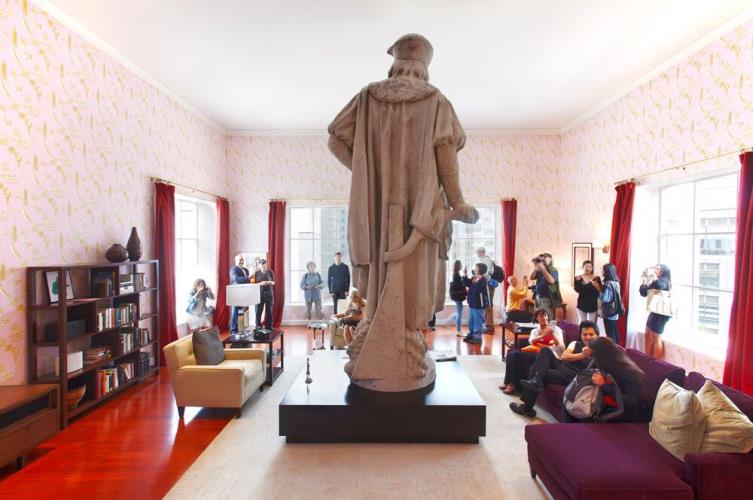Bachelor's degree with a double major in Chinese and Art in Peking University. Master of Art and Administration in New York University. She has served in the Macao Cultural Affairs Bureau, the New York City Department of Cultural Affairs and the Museum of Chinese in America, working as art administrator and curator. She is now working as an art educator and administrator in New York, as well as an independent curator and writer.

Japanese artist Tatzu Nishi: Discovering Columbus, 2012. Source: Public Art Fund
During my recent discussion about public art with friends in Shanghai, I was quite surprised when they told me there was actually little public art in Shanghai. As one of the most active artistic cities in China, Shanghai has arts districts, galleries, arts expositions, and arts biennials, but with the exemption of public art? This reminds me that our cultural production and consumption have skipped the educational link provided by public art while our concept of cultural industry has been developing rapidly in the past 20 years in Mainland China. Is it really adequate for a city to attract public attention to cultural creativity only by a few galleries?
Talking about culture and arts may prove, more often than not, to be quite abstract, but when people physically participate in arts, the appeal and impact that arts gives them is extremely direct. Therefore, one of the most effective ways to promote arts is to allow people to personally participate in arts activities, and public art can provide exactly such an opportunity: a city is the stage for arts and creativity. The residents can enjoy and participate in arts activities without the necessity of going to art galleries. This, of course, offers tremendous benefits for the shaping of the artistic atmosphere of the city and the cultivation of the cultural consumer groups.
I remember visiting New York some years ago. What impressed me most is not the Metropolitan Museum of Art, nor the Broadway musicals, but the public art materialised at the Columbus Circle in Manhattan, called “Discovering Columbus”. Like the squares in many other cities, the statue of a great figure stands at the centre of the square, a landmark of the city and a memory to history, it is the statue of Columbus, but because of its lofty height, no one has ever come close to enjoy it. Some artists then built a temporary shed surrounding the statue. People may go up a few steps and enter the shed to see the statue of Columbus at close quarters. Such a piece of art gives people a completely new perspective to view those fossilised things and matters in history and in the city. At the same time, it gives art a more positive social meaning: it is not placed in the art museum waiting to be enjoyed. Instead, it exerts itself directly into city life, integrating with space and history, and communicating with the people living in such a time and space.
People, perhaps, may say art itself is basically the product of a specific time and space. But it seems that following the development of artistic products being over-commercialised or even capitalised, artwork often dissociates itself from the original time and environment of the artists, and turns itself into an object of consumption and desire. Let alone whether those people who buy artwork at auctions at astronomical prices can appreciate art or not, how many of us who flock to art galleries and stand before the masterpieces of Van Gogh and Picasso can really communicate with the artists’ work? The dissociation of this kind of art with people, with living, and with society has forced American artists in the 1960s and 1970s to break down the white walls of art galleries and march into the streets again.
And it was at this very time that some important public art organisations in America were founded one after another: many states and cities began to promote the Percent for Art Plan and demand public facilities to invest 1% of their expenditures on purchase of public art on the one hand; and civilian non-profit-making organisations were established, like the Public Art Fund and Creative Time on the other. The emergence of these organisations not only provided resources, but also built a platform for community collaboration, making it possible for public art to penetrate into cities of various sizes in America.
However, public art using public resources comes into the sight of the public must naturally accept the examination of the public. It must inspire thoughts, and at the same time make itself accepted and agreed with by the public. Not only does it depend on the creativity and vision of the artists, but it should also consider the system of community participation, the implementation of public education, and others. From this, it should be said that public art is not merely a matter of just moving artwork from the galleries into the streets.